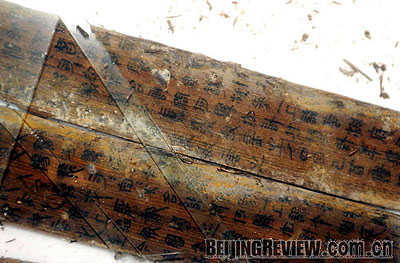|

One of the most poignant moments during the opening ceremony of the Beijing Olympic Games on August 8 was the scene where 3,000 performers in the guise of Confucius disciples, each holding a roll of bamboo-strip book, recited the Confucian classics.
This performance presented to the audience a very important period in the development of Chinese culture. It was called the Spring and Autumn Period (around 770-476 B.C.), a time of major social changes when various schools of political or philosophic thought emerged, including Confucianism, legist doctrine, Taoism and Mohism. The founders and representatives of these schools wrote books on their doctrines and debated with each other, giving rise to the blooming of academia in China's history. The thoughts during that period laid a solid foundation for the development of culture in China's feudalist period and also had a deep influence on ancient Chinese culture as a whole.
One of the crucial factors helping to support such cultural prosperity is the change of writing materials. When Chinese characters were first created, they were inscribed on animal bones, tortoise shells or bronze ware. But because these materials were not easy to find and difficult to inscribe, characters did not gain popularity. This meant that until the Shang Dynasty (17th century-11th century B.C.), those who could read or write were limited to a small group of intellectuals, which greatly affected the spread of knowledge and culture. This situation did not change until the appearance of books and documents written on bamboo or wood.
Before paper-making was invented by Cai Lun in A.D. 105 and the popularization of the use of paper in China in around 4th century, bamboo and wood were the major materials used to write on. Generally speaking, the bamboo strips were called jian and wood tablets were called du.
The research of historians shows that jian was normally used to write books, laws or important official documents, while du was used to write ordinary archives, account books or private letters. Archaeological discoveries showed that jian was very thin and slim with the width less than 1 cm and the length ranging between 10 cm to 70 cm.
Bamboo and wood were not the only materials used for writing in ancient China. Silk and satin were also used. But because silk was very expensive, ordinary people could not afford it, leaving the way open for jian and du that prevailed for more than 1,000 years. And so the records of culture were maintained.
"Bamboo-strip or wooden books played a very important role in spreading characters among ordinary people in ancient times as well as passing down the ancient civilization," said Professor Zhao Chao, a researcher of the Institute of Archaeology of the Chinese Academy of Social Sciences, on China's National TV station's program Lecture Room.
As the historical documents about the early part of China's history that have been passed down are very rare, bamboo strips today are very valuable.
"The discovery of ancient bamboo strips was one of the most important archaeological findings in the 20th century," Zhao said.
Bamboo-strip books are seen as the best materials for the study of the earliest Chinese manuscripts or documents. Li Ling, a professor of history at Peking University, who is one of the leading scholars in the study of ancient documents in China, said in his book named Ancient Documents and the Academic Development.
The meaning of the discovery of ancient books and documents does not lie in the finding of some unseen books, but in the challenge to historians of how to look at the writing styles, classification of ancient books, changes of texts, and the diversity and complexity of the ancient thoughts from a new and different angle, Li wrote in his book.
In the book, Li said that the custom of burying books together with their owners after they died started in the Warring States Period and became common in the Qin and Han dynasties (around 221 B.C.-A.D.220). But he added that whether to bury books or not was mainly a personal choice and had little to do with the social status of the people at that time.
Before the bamboo strips donated to Tsinghua University in July, there were only two large-scale discoveries of bamboo strips in China: one was the 800 bamboo strips unearthed in an ancient tomb found in Hubei Province in 1993 and the other was the over 1,000 bamboo strips collected by the Shanghai Museum in 1994. | 